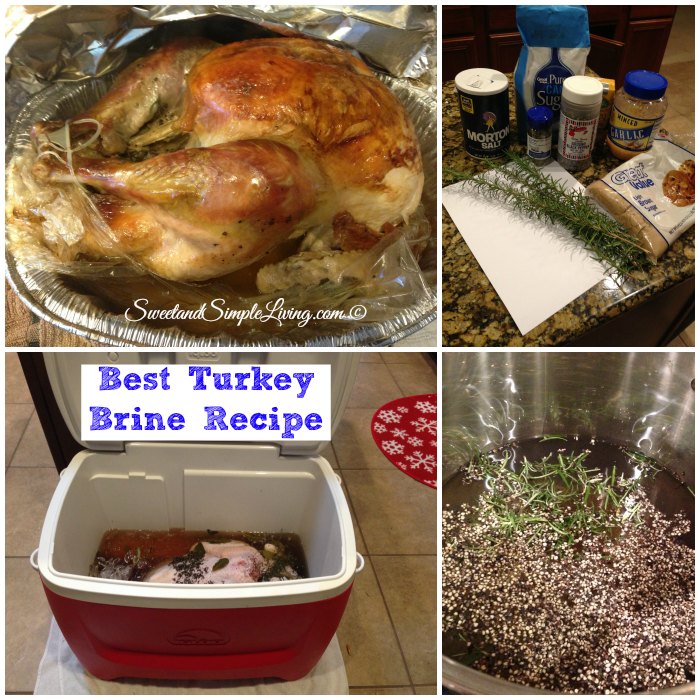Don’t be afraid to customize your brine with herbs, spices, and alternative liquids
As we mentioned previously, a brine offers plenty of space for experimentation and flavor preferences. When it comes to wet brines, chef (and Top Chef alum) Chris Scott of the Institute of Culinary Education explains that “the essentials for [wet] brining are salt and water. Whatever else you add to it is up to the chef’s discretion for flavoring. After making your brine, you can heat it to infuse all those flavors. Make sure you cool it completely before pouring it over raw poultry so it doesn’t cook it. Through osmosis, the flavors infuse into the bird.” Funwithfood/Getty Images
Funwithfood/Getty Images
Chef Joshua Smith, formerly of The Four Seasons Boston and now of New England Charcuterie in Waltham, MA, also likes to put his own stamp on a classic liquid brine, “brining [his] turkeys in buttermilk, fresh thyme, crushed garlic, and freshly cracked white pepper. We let this sit for at least 24 hours, and [the brine] yields great results. The great thing [about using buttermilk] is that the lactic acid starts to break down the muscle structure [of the turkey] while adding flavor and drawing out any blood. With 3-4% lactic acid, buttermilk also acts as a antimicrobial on any potential pathogens that may be present.”
“Wet” brining requires a long soak and “dry” brining requires a thorough rub, and both versions are completely equipped to do the job. Chef Chris Carter of Porter Road in Nashville, TN tells us that “choosing a wet versus a dry brine is a personal preference. Both styles of brining add incredible flavor to the turkey through the combination of salt and any other seasonings you choose to add, which penetrate into the meat over several hours (or, ideally, overnight). Wet brining allows the turkey to absorb additional moisture, whereas dry brining dries out the skin, so it can become deliciously crisp during the cooking process.”
Measurements don’t need to be precise; play around with flavors and adjust based on the size of your bird
Cooking a full Thanksgiving spread is stressful enough, and most hosts would probably prefer to avoid another round of ingredient measuring and weighing. Luckily, chef Ryan McCaskey of Acadia in Chicago, IL says that “the exact measurements aren’t as important [in a brine]. It’s more about adding and subtracting ingredients for the flavor profile you’re looking for and for the size of your bird!”
Really take your time with the brining process
Brine aficionados emphasize the importance of allowing your turkey to hang out in the brine (whether wet or dry) for a significant period of time, in order to reap all of the positive results. Chef John Lechleidner of WP24 by Wolfgang Puck in Los Angeles, CA really embraces the “slow burn” brine technique, describing his method of brining and roasting like so:
“First, you need to brine for 24-36 hours [Lechleidner prefers a ‘flavorful liquid’ brine]. When I make my brine, I keep it simple with just salt, water, sugar, peppercorn, garlic, onion and celery. Once your turkey is brined, let it sit in the fridge for 24 hours uncovered, so the skin dries out. Before you cook your turkey, let it sit out for about 3 hours on the counter uncovered to help do a final push to dry the skin out. You can roast your turkey covered for about an hour, then finish roasting uncovered. This should give you a moist and crispy turkey skin. Let the turkey rest for 30-40 minutes before carving the turkey. While it is resting, you can make your pan gravy and have it ready at the same time.”
A slow roast followed by a heat “blast” will offer an ideal blend of juicy meat and crispy skin
Chef Eli Collins of a. kitchen and a. bar in Philadelphia, PA likes to add some roasting-temp variety to highlight the flavors imparted by a brine. He advises our readers to “roast [the brined turkey] at a low temperature and take it out when it’s about three-quarters of the way done, Let it sit for an hour, then blast it with high heat. The crispiness of the skin comes from drying it [post-brine], then cooking it at a low enough temperature so the skin renders. Blasting it is almost like air-searing it; the turkey emerges juicy with savory, crispy skin.”

If you’d like to give turkey-brining a shot this year, we have a couple of unique brine recipes well worth trying:
Ceylon and Herb Turkey Brine Recipe
(Created by Heather Pelletier, Executive Chef, Chumley’s, New York City)
Chef Heather Pelletier of Chumley’s, a historic NYC pub where F. Scott and Zelda Fitzgerald were once regulars, likes to infuse her turkey brine with Ceylon tea, appreciating the citrus notes added by this ingredient.
Ingredients:
- 6 quarts water
- 1.5 cups salt
- 1-3 bags of Ceylon tea
- 2 heads garlic
- 1 bay leaf
- Peels and juice of several lemons and oranges, to taste
- Rosemary, to taste
- Thyme, to taste
- Sage, to taste
- Black pepper, to taste
- Coriander, to taste
Method:
- Place all ingredients in a pot with 3 quarts water and bring to a boil.
- Turn off heat and add 3 quarts freezing-cold water (if you want, half of this could even be ice) to quickly cool the boiling water.
- Once the water is VERY cold, add the turkey and then put in the fridge for 24 hours.
- Remove turkey and pat the skin dry. Put back in the fridge for 24 hours to continue to dry out.
- ur meat and refrigerate overnight, or up to 3 days. Remove meat and let air dry before cooking.
The post How Exactly Do You Brine a Turkey? appeared first on The Manual.

Comments